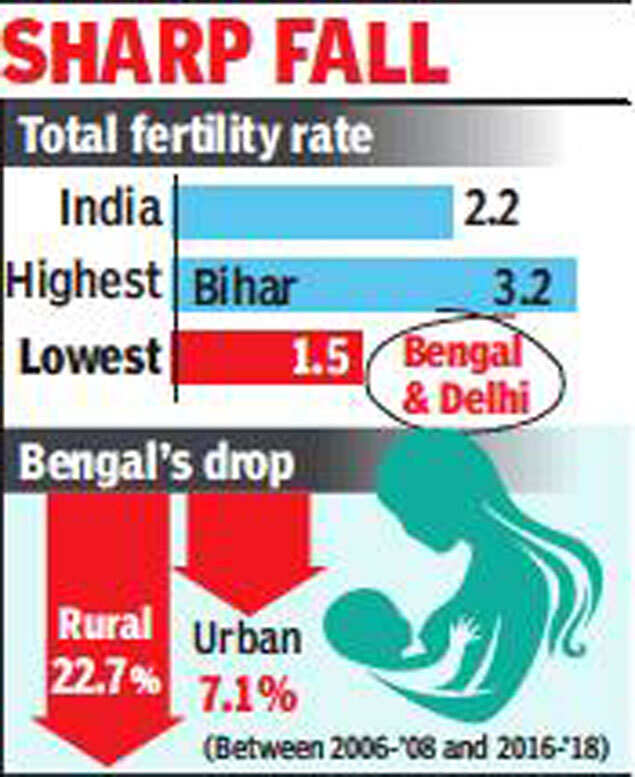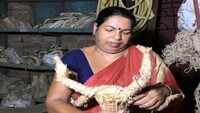
KOLKATA: Rural Bengal has seen a sharp drop in fertility rate, compared with urban Bengal’s, latest Census data indicate.
The total fertility rate (TFR) — the statistical count of the average number of children expected to be born per woman during her reproductive age — in rural Bengal has dropped by as much as 22.7% in the decade between 2006-’08 and 2016-’18, while it has fallen 7.1% in urban parts of the state.

The nation’s overall TFR is 2.2, with Bihar on top (3.2), and Bengal and Delhi (with 1.5) sharing the bottom rung.
The trend is borne out by data about general fertility rate (GFR), which is the number of live births per 1,000 women in the reproductive age group of 15-49 years. At the national level, 70.4 children were born to every 1,000 women aged 15-49. The GFR number varies from 48.6 in Kerala to 99.8 in Bihar. In Bengal, it is 50. Rural Bengal recorded 55 and urban Bengal recorded a GFR of 38.5. But the GFR of rural Bengal has dropped by 24.9%, whereas the corresponding drop in urban Bengal was 10.6%.
The drops mirror a pan-India trend. GFR in India has dropped by 19.8% over the same decade.
Bengal, however, shows a curious trend, along with Andhra Pradesh and Maharashtra, of women having children early. Along with these states, Bengal’s fertility reached a peak in the age group of 20-24. Across India, the figure is 25-29. Only in Jammu & Kashmir did fertility reach its peak in the age group 30-34.
This data was part of the Sample Registration System (SRS) Statistical Report 2018, released recently.
Experts felt that Bengal was among the better states in terms of TFR, in which it has anyway had a consistently good record. But the TFR should have improved more over the years, which it hasn’t, because of lack of awareness and economic factors, they pointed out. “Unfortunately, the level of awareness in our state is abysmally low, even among the educated population,” said fertility expert Gautam Khastagir. “Eventually, it boils down to the fact that the state has not made desired economic progress, which could have helped keep the fertility rate in check.”
Apollo Gleneagles Hospital consultant Shyamashis Bandopadhyay agreed. He, too, pointed out that while the fertility rate in Bengal has been satisfactory, it was lower in some states. “While it is good that Bengal is still lower than the national average, I believe states like Kerala and Maharashtra are doing better. So, we must be somewhere in the middle, and there is always the possibility of slipping. Historically, Bengal has always had an educated, enlightened population that has helped keep both fertility rate and birth rate in check. But there is also a huge rural population that remains largely out of reach of government-sponsored campaigns. As long as we don’t reach out to them, the rate won’t drop significantly,” said Bandopadhyay.
The total fertility rate (TFR) — the statistical count of the average number of children expected to be born per woman during her reproductive age — in rural Bengal has dropped by as much as 22.7% in the decade between 2006-’08 and 2016-’18, while it has fallen 7.1% in urban parts of the state.

The nation’s overall TFR is 2.2, with Bihar on top (3.2), and Bengal and Delhi (with 1.5) sharing the bottom rung.
The trend is borne out by data about general fertility rate (GFR), which is the number of live births per 1,000 women in the reproductive age group of 15-49 years. At the national level, 70.4 children were born to every 1,000 women aged 15-49. The GFR number varies from 48.6 in Kerala to 99.8 in Bihar. In Bengal, it is 50. Rural Bengal recorded 55 and urban Bengal recorded a GFR of 38.5. But the GFR of rural Bengal has dropped by 24.9%, whereas the corresponding drop in urban Bengal was 10.6%.
The drops mirror a pan-India trend. GFR in India has dropped by 19.8% over the same decade.
Bengal, however, shows a curious trend, along with Andhra Pradesh and Maharashtra, of women having children early. Along with these states, Bengal’s fertility reached a peak in the age group of 20-24. Across India, the figure is 25-29. Only in Jammu & Kashmir did fertility reach its peak in the age group 30-34.
This data was part of the Sample Registration System (SRS) Statistical Report 2018, released recently.
Experts felt that Bengal was among the better states in terms of TFR, in which it has anyway had a consistently good record. But the TFR should have improved more over the years, which it hasn’t, because of lack of awareness and economic factors, they pointed out. “Unfortunately, the level of awareness in our state is abysmally low, even among the educated population,” said fertility expert Gautam Khastagir. “Eventually, it boils down to the fact that the state has not made desired economic progress, which could have helped keep the fertility rate in check.”
Apollo Gleneagles Hospital consultant Shyamashis Bandopadhyay agreed. He, too, pointed out that while the fertility rate in Bengal has been satisfactory, it was lower in some states. “While it is good that Bengal is still lower than the national average, I believe states like Kerala and Maharashtra are doing better. So, we must be somewhere in the middle, and there is always the possibility of slipping. Historically, Bengal has always had an educated, enlightened population that has helped keep both fertility rate and birth rate in check. But there is also a huge rural population that remains largely out of reach of government-sponsored campaigns. As long as we don’t reach out to them, the rate won’t drop significantly,” said Bandopadhyay.

Coronavirus outbreak
Trending Topics
LATEST VIDEOS
City
 Watch: CM Yogi lights earthen lamps at residence as part of 'deepotsav'
Watch: CM Yogi lights earthen lamps at residence as part of 'deepotsav'  'Wanted to teach Hindus a lesson' using political power, ex-AAP councillor Tahir Hussain confesses
'Wanted to teach Hindus a lesson' using political power, ex-AAP councillor Tahir Hussain confesses  48-hour countdown to Ram Mandir Bhumi Pujan in Ayodhya; invitation cards sent
48-hour countdown to Ram Mandir Bhumi Pujan in Ayodhya; invitation cards sent  UP CM Yogi Adityanath takes stock of preparations in Ayodhya ahead of Ram Temple bhumi pujan ceremony
UP CM Yogi Adityanath takes stock of preparations in Ayodhya ahead of Ram Temple bhumi pujan ceremony
More from TOI
Navbharat Times
Featured Today in Travel
Get the app





